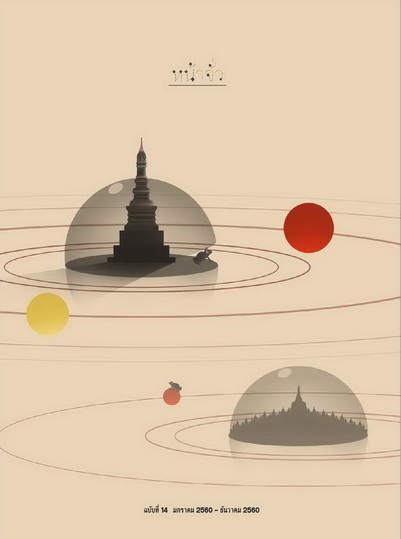รูปทรง และการจัดวางที่ว่างภายในเรือนพื้นถิ่นไทลื้อ : บ้านแปน เมืองนุน สิบสองปันนา ยูนนาน สาธารณรัฐประชาชนจีน/ House form and Space Organization of Dai Lue Vernacular Dwelling Houses: Manbiancun Village, Menglunzhen, Xishuangbanna, Yunnan, People’s Republi
Main Article Content
Abstract
บทคัดย่อ
บทความนี้เป็นการศึกษาเกี่ยวกับการวิเคราะห์และสังเคราะห์แบบแผนของเรือน การจำแนกประเภทของเรือน ลักษณะความสัมพันธ์พื้นที่ใช้สอยของเรือน และศึกษาถึงพัฒนาการของเรือนพื้นถิ่นไทลื้อ ซึ่งในประเด็นศึกษาดังกล่าวเกิดมาจากแนวความคิดของคำถามที่ว่า ความหลากหลายของรูปทรงหลังคาของเรือนจะส่งผลให้ผังพื้นของเรือนแตกต่างกันหรือไม่ และรูปแบบของเรือนแต่ละหลังมีพัฒนาการอย่างไร ผู้วิจัยได้คัดเลือกหมู่บ้านตัวอย่างคือ “บ้านแปน (Manbiancun)” ซึ่งเป็นชุมชนดั้งเดิมที่มีความสำคัญในทุ่งเมืองนุน เขตสิบสองปันนา เป็นตัวแทนของชุมชนในเขตเมืองนูน และได้คัดเลือกเรือนกรณีศึกษาที่มีรูปทรงที่ต่างกันจำนวน 7 หลัง เพื่อวิเคราะห์ประเด็นตามวัตถุประสงค์ของการศึกษาข้างต้น และทำความเข้าใจของการศึกษาในระดับจุลภาคก่อน เพื่อนำไปสู่การต่อยอดความรู้ของการศึกษาในระดับมหัพภาคในอนาคตต่อไปได้ ซึ่งสามารถสรุปผลการศึกษาได้ 3 ประเด็น ดังนี้
ประเด็นที่ 1 “การจำแนกประเภทของเรือน” สรุปได้ว่ามีรูปแบบเรือนทั้งหมด 6 รูปแบบ ได้แก่ เรือนแฝดเยื้อง, เรือนแฝดเยื้องมีเรือนขวาง, เรือนแฝดมีเรือนขวาง, เรือนสามจั่วมีเรือนขวาง, เรือนสี่จั่ว และเรือนสี่จั่วมีเรือนขวาง ทั้งนี้ไม่พบรูปแบบเรือนเดี่ยว หรือเรือนหงส์ (เฮินหงส์) แล้ว ซึ่งเป็นเรือนดั้งเดิมของกลุ่มชาติพันธุ์ไทลื้อ
ประเด็นที่ 2 “ลักษณะความสัมพันธ์ระหว่างรูปทรงหลังคากับพื้นที่ใช้สอยของเรือน” สรุปได้ว่า พื้นที่ใช้สอยที่อยู่ใต้หลังคาเรือนหลวง ต้องเป็นพื้นที่ส่วนที่สำคัญที่สุดของเรือน ได้แก่ ส้วมนอน (ห้องนอน) และห้องโถง ส่วนพื้นที่ใช้สอยที่อยู่ใต้หลังคาเรือนต่อขยายด้านข้าง จะเป็นพื้นที่ส่วนครัว และพื้นที่ใช้สอยที่อยู่ใต้หลังคาเรือนขวาง มักจะเป็นบันได ระเบียงหน้า (หัวค่อม) บางหลังมีห้องนอน หรือห้องเก็บของอยู่ข้างบันไดด้วย นอกจากนี้ยังมีชานแดด (จาน) อยู่นอกพื้นที่ใต้หลังคา มักจะพบถังเก็บน้ำ หรือห้องอาบน้ำและห้องขับถ่าย รวมอยู่ในพื้นที่ชานแดดด้วย
ประเด็นที่ 3 “พัฒนาการของเรือน” สรุปได้ว่า ความหลากหลายของรูปแบบหลังคาเรือนไม่ได้มีผลต่อรูปแบบแผนผังของเรือน ซึ่งการจัดวางความสัมพันธ์ของพื้นที่ใช้สอยของเรือนและลำดับการเข้าถึงพื้นที่ต่างๆ ยังคงมีความคล้ายคลึงกันอยู่ แต่ด้วยขนาดของพื้นที่ที่เปลี่ยนไปจึงทำให้ระบบโครงสร้างของหลังคาจะต้องเปลี่ยนแปลงวิธีการก่อสร้างตามไปด้วย พร้อมทั้งข้อจำกัดของวัสดุก่อสร้างและค่านิยมส่วนบุคคลเป็นผลทำให้รูปแบบของเรือนมีการเปลี่ยนแปลงอยู่ตลอดจนกลายเป็นพัฒนาการ
Abstract
This article explores the synthesis, analysis, and classification or typology of Dai Lue vernacular houses. The study focuses on the relationship between the roof forms and the functional areas, along with the study of the development of the Dai Lue houses. The study was arisen by issues from the following questions: does the variety of roof forms result in a floor plan, and how has each house and layout of Dai Lue house been developed? The researcher started the study by selecting the sample villages as "Manbiancun", a traditional community that is important in Menglunzhen Township, Xishuangbanna. There are also traditional patterns of settlement in the Dai Lue community. Then, 7 different case studies were selected for analyzing the issues for the purpose of the study and understanding of the micro-scale study first, leading to enhance the knowledge of the macro-scale study in the future. The conclusion of the study can be categorized into three points:
The first conclusion is about the typology of the house which can be classified into six forms: (1) houses built in skew parallel; (2) houses built in skew parallel mixed with crossing houses; (3) houses built in parallel mixed with crossing houses; (4) three-gabled houses mixed with crossing houses; (5) four-gabled houses; and (6) four-gabled houses mixed with crossing houses. The format of a single house or “Huen Hong” (swan-shape house), which was the original house of Lue ethnic, was not found.
The second conclusion is the relationship between the roof forms and the functional areas. This can be concluded that the area beneath the main house is the most important part of the house, including a bedroom and a hall, with usable space under side-extension roof, which is a kitchen, and the space under the crossing roof is often the main stairs and veranda. There is a bedroom or a storage beside the stairs in some houses. Moreover, there is also the outside terrace which was under the roof. It was also found that a water tank or a bathroom and a toilet were included in the terrace as well.
The third conclusion is about the development of the house, which can be concluded that the variety of roof forms does not affect the layout plan of the house. The layout of the functional area of the house and the sequence of the access are still similar. However, the size of the area needs to be changed, and this affects the roof structure system and construction methods as well. In addition, the limitations of materials and personal values have been changing over time, hence these factors bring about the development of housing.


